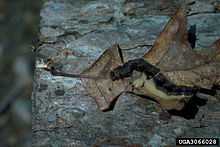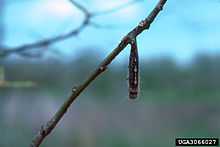Nuclear Polyhedrosis Virus
| Nuclear Polyhedrosis Virus | |
|---|---|
| Virus classification | |
| Group: | Group I (dsDNA) |
| Family: | Baculoviridae |
| Genus: | Alphabaculovirus |
| Species: | Nuclear Polyhedrosis Virus |


The nuclear polyhedrosis virus (NPV) which belongs to the sub group Baculoviruses is a virus affecting insects, predominantly moths and butterflies. It has been used as a pesticide for crops infested by insects susceptible to contraction. Though commercialization of the viral pesticide is slow as the virus is very species specific, making it effective under certain circumstances.
The virus strain itself is protected in a polygonal structured capsid. This enables the virus to infect cells more easily, and aids in reproduction of the virus. When the capsid is broken down within a host, virus strains are released and begin reproduction. Once there is a significant buildup of virus, symptoms become noticeable.
Heliothis sp. is a cosmopolitan insect pest attacking at least 30 food and fibre yielding crop plants. They have been controlled by the application of NPV's Baculovirus heliothis. In 1975, Environmental Protection Agency, U.S.A. registered the B.heliothis preparations.
Symptoms
Symptoms are:
- Discoloration (brown and yellow)
- Stress (regurgitation)
- Decomposition (liquification)
- Lethargy (slow-moving to no movement at all. Refusal to eat)
The virus enters the nucleus of infected cells, and reproduces until the cell is assimilated by the virus and produces crystals in the fluids of the host. These crystals will transfer the virus from one host to another.
The host will become visibly swollen with fluid containing the virus and will eventually die—turning black with decay.
Transmissibility
The virus is unable to affect humans in the way it affects insects: human cells are acid-based, while this virus requires an alkaline-based cell in order to replicate.
It is possible for the virus crystals to enter human cells, but not replicate to the point of illness.
It is transferred from insect to insect through crystals in all of their bodily emissions. As the virus is in the crystal-like capsid, it must be broken down by the alkaline digestive system of the insects to be released.
Mortality in infected insects is nearly 100%
Bleach and ultra-violet light have been found to prove effective in killing the virus.
Applications
Lymantria dispar, a serious pest of forest trees, commonly known as gypsy moth, has been successfully contained by releasing gypsy moth Baculovirus (NPV) preparations.
Another pest of forest trees, species of sawfly (Neodiprion sertifer, N. lecontei, N. pratti pratti, etc.), have been successfully controlled by NPV treatments specific to them.
NPV preparations have also been commercially used against pests such as Trichoplusia (under the biotrol-VTN brand name) and cotton leafworm (Spodoptera litura) (biotrol-VSE brand name).
References
http://www.bio.davidson.edu/.../virusstructure.html
http://www.geocities.com/rainforest/2153/np.html
http://www.nysaes.cornell.edu/ent/biocontrol/pathogens/viruses.html
http://www.answers.com/topic/nuclear-polyhedrosis-virus?cat=technology
A Text Book Of Biotechnology by R.C. Dubey ISBN 81-219-2608-4